The NVIDIA GeForce GTX 780 Ti Review
by Ryan Smith on November 7, 2013 9:01 AM ESTOverclocking
Finally, let’s spend a bit of time looking at the overclocking prospects for the GTX 780 Ti. Although GTX 780 Ti is now the fastest GK110 part, based on what we've seen with GTX 780 and GTX Titan there should still be some headroom to play with. Meanwhile there will also be the matter of memory overclocking, as 7GHz GDDR5 on a 384-bit bus presents us with a new baseline that we haven't seen before.
| GeForce GTX 780 Ti Overclocking | ||||
| Stock | Overclocked | |||
| Core Clock | 876MHz | 1026MHz | ||
| Boost Clock | 928MHz | 1078MHz | ||
| Max Boost Clock | 1020MHz | 1169MHz | ||
| Memory Clock | 7GHz | 7.6GHz | ||
| Max Voltage | 1.187v | 1.187v | ||
Overall our overclock for the GTX 780 Ti is a bit on the low side compared to the other GTX 780 cards we’ve seen in the past, but not immensely so. With a GPU overclock of 150MHz, we’re able to push the base clock and maximum boost clocks ahead by 17% and 14% respectively, which should further extend NVIDIA’s performance lead by a similar amount.
Meanwhile the inability to unlock a higher boost bin through overvolting is somewhat disappointing, as this is the first time we’ve seen this happen. To be clear here GTX 780 Ti does support overvolting – our card offers up to another 75mV of voltage – however on closer examination our card doesn’t have a higher bin within reach; 75mV isn’t enough to reach the next validated bin. Apparently this is something that can happen with the way NVIDIA bins their chips and implements overvolting, though this the first time we’ve seen a card actually suffer from this. The end result is that it limits our ability to boost at the highest bins, as we’d normally have a bin or two unlocked to further increase the maximum boost clock.
As for memory overclocking, we were able to squeeze out a bit more out of our 7GHz GDDR5, pushing our memory clock 600MHz (9%) higher to 7.6GHz. Memory overclocking is always something of a roll of the dice, so it’s not clear here whether this is average or not for a GK110 setup with 7GHz GDDR5. Given the general drawbacks of a wider memory bus we wouldn’t be surprised if this was average, but at the same time in practice GK110 cards haven’t shown themselves to be as memory bandwidth limited as GK104 cards. So 9%, though a smaller gain than what we’ve seen on other cards, should still provide GTX 780 Ti with enough to keep the overclocked GPU well fed.
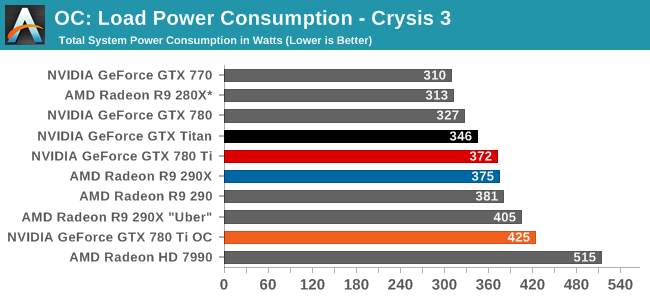
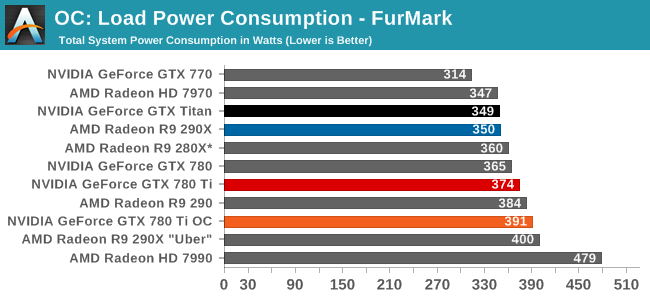
Starting as always with power, temperatures, and noise, we can see that overclocking GTX 780 Ti further increases its power consumption, and to roughly the same degree as what we’ve seen with GTX 780 and GTX Titan in the past. With a maximum TDP of just 106% (265W) the change isn’t so much that the card’s power limit has been significantly lifted – as indicated by FurMark – but rather raising the temperature limit virtually eliminates temperature throttling and as such allows the card to more frequently stay at its highest, most power hungry boost bins.
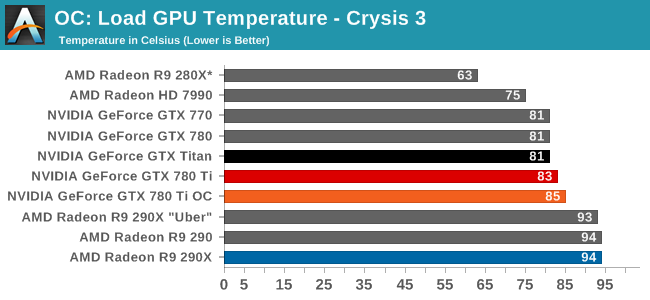

Despite the 95C temperature target we use for overclocking, the GTX 780 Ti finds its new equilibrium point at 85C. The fan will ramp up long before it allows us to get into the 90s.
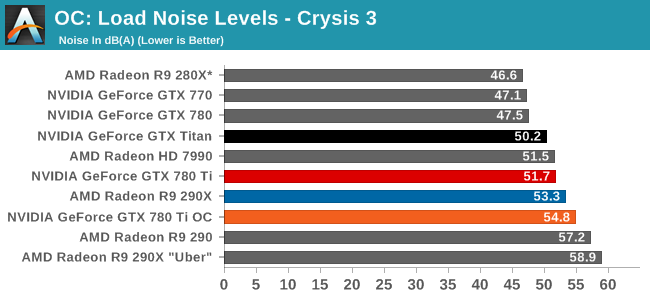
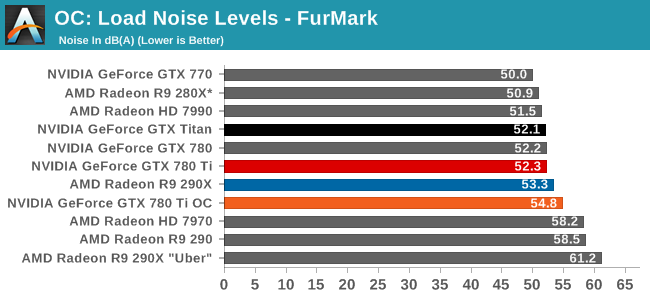
Given the power jump we saw with Crysis 3 the noise ramp up is surprisingly decent. A 3dB rise in noise is going to be noticeable, but even in these overclocked conditions it will avoid being an ear splitting change. To that end overclocking means we’re getting off of GK110’s standard noise efficiency curve just as it does for power, so the cost will almost always outpace the payoff on a relative basis.
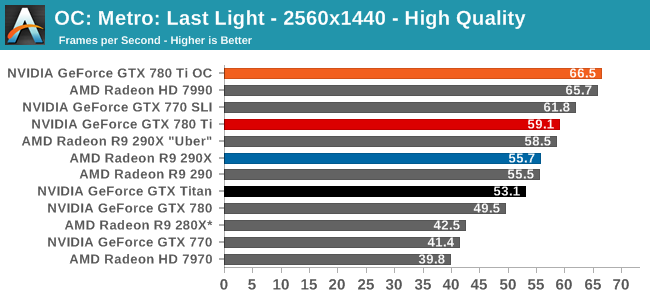
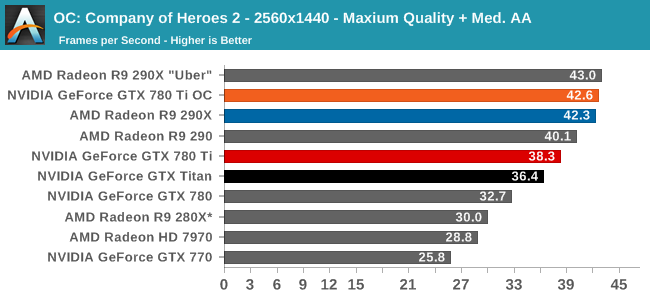
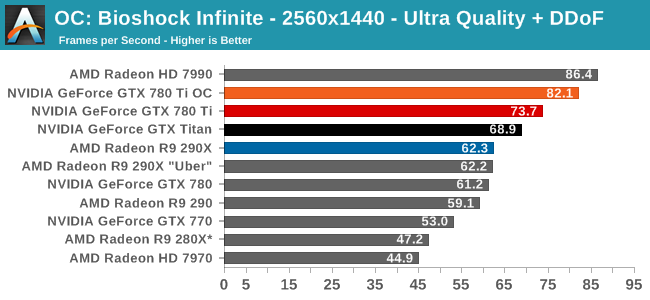
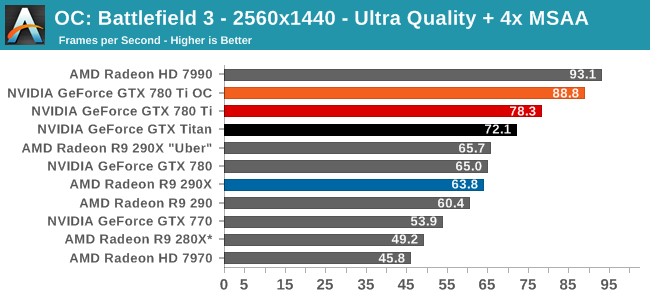
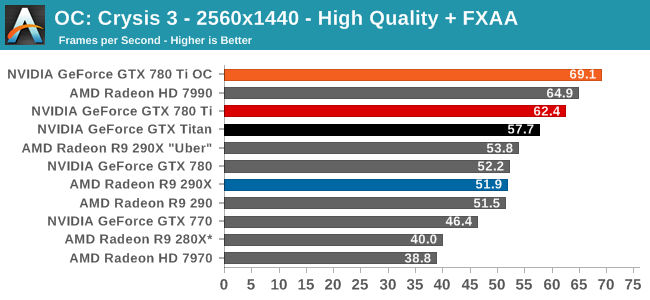
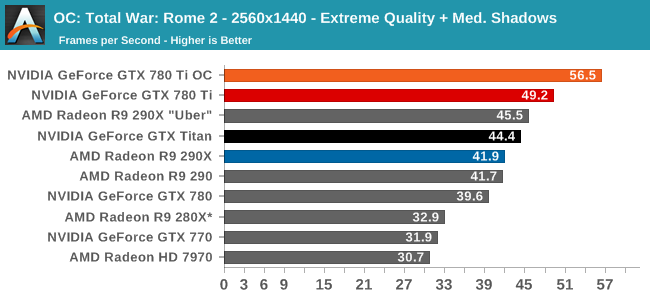
Finally, looking at gaming performance the the overall performance gains for overclocking are generally consistent. Between our 6 games we see a 10-14% performance increase, all in excess of the memory overclock and closely tracking the GPU overclock. GTX 780 Ti is already the fastest single-GPU card, so this only further improves its performance lead. But it does so while cutting into whatever is above it, be it the games where the stock 290X has a lead, or multi-GPU setups such as the 7990.










302 Comments
View All Comments
will1956 - Monday, December 2, 2013 - link
troll but trueRajiv Kishore - Thursday, November 7, 2013 - link
Waiting on 290 with better cooling, will ask my sis to pick 1 up when she's coming back to india. Nvidia 780ti is overkill for my 1080p screen. Gj nvidia can't wait for maxwell! Still single gpu king.HalloweenJack - Thursday, November 7, 2013 - link
So it uses as much power as the R290X , its thermal load is set lower and its nearly as noisy under load. but its faster and costs a lot more.R290 is the winner here - $200 cheaper , add an aftermarket cooler or wait for the AIB to be unleashed , and for less money you`ll have a faster (factory overclocked , or oc yourself) R290 which beats the 780Ti
A5 - Thursday, November 7, 2013 - link
1) A 3dB difference means that the R290X in "standard" mode is twice as loud as the 780 Ti.2) In "Uber" mode, which is what the 290X has to use to match performance, it is 8dB louder. That is a huge difference.
Traciatim - Thursday, November 7, 2013 - link
A5, that point 1 is incorrect. 3dB is twice the power but not twice as loud. 3dB is about where anyone can perceive a loudness difference, 10dB is generally what is perceived as twice as loud.tedders - Thursday, November 7, 2013 - link
While the results speak for themselves, I cannot wait to see what a properly air cooled 290X will be able to do against a 780ti. It has pretty much shown that the stock reference cooler on the 290X is its bottleneck. Will you be revisiting the 290X review once the other manufactures come out with their properly cooled cards?pyroHusk - Thursday, November 7, 2013 - link
Completely agree with you, R9 290X clock rate throttle so much by the crap reference cooler. Reviewer from techspot replace R9 290 reference cooler with HIS IceQ X2 from R9 280X and temperature drop to 60-70C easily.nathanddrews - Thursday, November 7, 2013 - link
Tom's also replaced the 290 cooler with a tri-fan setup and saw a 20% fps gain without all the noise. Seems to me that a $400 290 + a high quality cooler ($50?) will get you close to the 780ti for $250 less.hoboville - Thursday, November 7, 2013 - link
Once reviews from both sides come in (when both sides come out with third-party coolers), then we can see how these cards stack up. Right now, the AMD cards can't be realistically overclocked (or in the case of the 290X realistically reach its innate performance). The numbers from Tom's hardware are promising, but who knows what ASUS and the rest will pull out of their hats.Hopefully by mid December we can make good informed decisions, but for now, it's just too early to buy. There's still rumors that Never Settle will come into the picture, so waiting is good.
IanCutress - Thursday, November 7, 2013 - link
A high quality VGA air cooler is more like $100-$120. Or strap on a closed loop liquid cooler